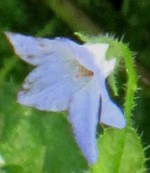 This herbaceous perennial is native to Corsica and Sardinnia where it grows shady, rocky places and is particularly abundant after forest fires. It is a member of the borage family, Borginaceae, what also includes Virginia bluebells, forget-me-nots, and lungwort. The stems are branched and may be creeping or ascending. They have backward-pointing bristles and carry 0bvate to oblong leaves. Coarse basal leaves are four to six inches long and are coarsely hairy. The nodding pale blue flowers appear in late spring and persist for about a month. They are bell-shaped, 3/4″ inch across, and carried in loose racemes. Plants readily self-seed. A good choice for a wall or rock garden. The specific epithet, laxiflora, comes from the Latin words laxus meaning loose, and flora meaning flower, and refers to the inflorescence.
This herbaceous perennial is native to Corsica and Sardinnia where it grows shady, rocky places and is particularly abundant after forest fires. It is a member of the borage family, Borginaceae, what also includes Virginia bluebells, forget-me-nots, and lungwort. The stems are branched and may be creeping or ascending. They have backward-pointing bristles and carry 0bvate to oblong leaves. Coarse basal leaves are four to six inches long and are coarsely hairy. The nodding pale blue flowers appear in late spring and persist for about a month. They are bell-shaped, 3/4″ inch across, and carried in loose racemes. Plants readily self-seed. A good choice for a wall or rock garden. The specific epithet, laxiflora, comes from the Latin words laxus meaning loose, and flora meaning flower, and refers to the inflorescence.
Type: Herbaceous perennial
Bloom: Nodding pale blue flowers in loose racemes in late spring to early summer
Size: 1-2” H x 1” W
Light: Sun to shade; some shade in the South
Soil: Lean, medium moist, very well-drained
Care: Mulch in the fall
Hardiness: Zones 5-9
Pests and Diseases: Leaf-mining sawflies, slubs, powdery mildew
Propagation: Division in spring, seeds in fall, two to three inch long terminal cuttings in summer
Companion Plants: Ajuga, Bergenia cordifolia, Epidmedium x perralchicum, Convallaria majalis, Tellima grandiflora, Geranium nodosum